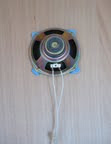
The Opening Speech
by Prof. Jean-Baptiste Joly, the director of the Akademie Schloss SolitudeGoh Lee Kwang befindet sich in der Tradition der Musique Concrète, Ende der Vierziger in Frankreich von Pierre Schaeffer gegründet. „ Es wurde mir vorgeworfen, so Pierre Schaeffer, das Geräusch in die Musik eingeführt zu haben. Eher auf das Gegenteil bin ich stolz (...) Komponisten und Zuhörer habe ich aufgefordert, ihr Gehör von der Konvention des Zuhörens zu befreien, indem sie den primären Gegensatz zwischen Klang und Geräusch in Frage stellen; dadurch konnten sie das musikalische Potenzial entdecken, das in gewöhnlich als Geräusche wahrgenommenen Tönen oder auch die impliziten Geräusche in so genannten reinen Tönen steckt“. Ausgangspunkt der Installation von Goh Lee Kwang „Vibrate Weather“ sind Geräusche und Klänge, die er aus dem Fenster seines Studios in Kuala Lumpur aufgenommen hat: Regen, Wind, Sturm, insgesamt drei Stunden Samples, die zum Teil unverändert, zum Teil elektronisch verarbeitet zu hören sind. Die Samples sind in der Regel zwei Minuten lang und werden per Zufall gespielt, so dass die Möglichkeit der Kombinationen fast unendlich ist.
Aber Vibrate Weater ist nicht nur eine Akusmatische Installation (akusmatisch nennt man ein Geräusch, das man hören kann, ohne dessen Ursachen zu sehen), es hat auch mit den großen Spiegeln, die im Raum stehen und eine Art Schutz vor dem Unwetter zu bilden scheinen, einen starken visuellen Charakter. Die musique acousmatique brachte eine neue Art des Zuhörens mit sich, jedoch konnte keiner voraussehen, wie sehr es für das Publikum eine Plage sein würde, sich im Konzertsaal mit leerer Bühne auf unbewegliche Lautsprecher konzentrieren zu müssen. Damit Klänge und visuelle Elemente, wie in Vibrate Weather, auf derselben Ebene der Wahrnehmung funktionieren können, muss die Musik oder der Klang die Sakralität des Konzertsaals aufgeben und Formen der Aufführung finden, die der Möglichkeit ihrer Wiederholbarkeit und ihrer Instrumenten- und Interpretenlosigkeit entsprechen.
Goh Lee Kwang gehört zu jenen Klangkünstlern, die die von der Musique Concrète verursachte Trennung zwischen Sehen und Hören aufheben. Das Visuelle Element, die Spiegelfolien geraten je nach Klang paarweise in Schwingung, so dass man deren Entwicklung nicht nur hört, sondern auch sieht, manchmal sogar sieht, bevor man sie hört. Die Klänge, die hier ertönen, finden nicht mehr als Musik in einem organisierten Zeitsegment statt, denn diese kennt weder Anfang noch Ende und wird hier auch wie ein Bild ausgestellt. Hier ist der Klang ein Element des Visuellen, wird das Visuelle zu einem Element des Klangs.
© Jean-Baptiste Joly
Translated by Dr Volker Wolf , the director of the Goethe-Institut Kuala Lumpur, Malaysia.Goh Lee Kwang is working in the tradition of Musique Concrete, which was founded by Pierre Schaeffer towards the end of the 1940s. “I was reproached“ writes Pierre Schaeffer, „ to have introduced noise into music. I am proud of the contrary (…), because I asked composers and listeners to free themselves from the convention of listening by questioning the contrast between sound and noise; only by doing that could they discover the musical potential, which is hidden in tunes which are usually heard as noise or which are noise implicit in pure tunes.” The starting point of Goh Lee Kwang’s installation “Vibrate Weather” are noises and sounds, which he recorded from the window of this studio in Kuala Lumpur: Rain, wind, storm – altogether three hours of samples, which can be heard in their natural or partially electronic format. The samples are normally two minutes long and are played accidentally, which allows for their infinite combinations.
But „Vibrate Weather“ is not only an acusmatic installation („acusmatic“ means that we can hear some noises without realizing their origin), it also has a strong visual character due to the big mirrors, which are set up in the room and which form some kind of protection against extreme weather. Musique acousmatique was accompanied by a new kind of listening, but no one could foresee the frustration of an audience, which has to concentrate on an empty stage with immovable loudspeakers. In order for sounds and visual elements – like in Vibrate Weather – to work on the same level of sensual perception, music or sounds have to relinquish the sacrosanct aura of the concert hall and find different formats of performance, which correspond to the repetition and to the lack of instruments and interpreters.
Goh Lee Kwang is one of those sound artists, who abolish the separation between watching and listening, which was caused by Musique Concrete. The visual element, the mirror sheets begin swinging together with the sound in such a way that their development is not only audible, but also visual, before they can be heard. The sounds that can be heard do not happen as music during certain duration of time, because they have no beginning and no end but are exhibited like pictures. Sound becomes an element of visual experiences; the visuality becomes an element of sound.


